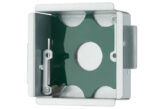
The aim of this article from the experts at NICEIC is to provide guidance on suitable measures to prevent and mitigate the risk of spread of fire and smoke when installing wiring systems that penetrate the building fabric.
This article considers the methods for fire sealing where wiring systems and openings are made within the building fabric during electrical installation work.
One of the most commonly recurring non-compliances seen during an annual assessment is the absence, or inadequate sealing, of cable penetrations passing through the fabric of a building.
A fire can spread rapidly through a building where permanent openings are present and especially where flammable materials are often used for construction. The need to provide fire sealing is a fundamental requirement of the Building Regulations in England, Wales, Scotland and Northern Ireland and is recognised in Regulation Group 527.2 and Appendix 13 of BS 7671.
It is important to remember that the integrity of the fire resisting linings must be maintained throughout the building’s construction.
Fire sealing
The risk of spread of fire, and of the products of combustion such as smoke, fumes and flammable gasses should be minimised by the selection of appropriate materials and sound installation work practices (527.1.1). The installation of a wiring system shall not detrimentally affect either the structural integrity or fire safety of a building (527.1.2).
The requirements of Regulation Group 527.2 and the relevant building regulations are intended to preserve the:
• fire separation between areas of the building; and
• structural stability of the premises in the event of a fire.
It is recognised that, in most domestic type premises, it is the loadbearing capacity of floors that is threatened by early failure of the ceiling linings due to fire.
The requirements to seal openings apply wherever a wiring system passes through an element of building fabric having specific fire-resistant properties. The ability of the element to resist the spread of fire once breached is likely to have been compromised. Regulation Group 527.2 highlights the need for sealing such elements especially where wiring or cable management systems have penetrated the fabric of a building’s construction, including floors, walls, ceilings and the like.
Many modern forms of engineering construction use Structural Insulated Panels (SIPs) and include other elements such as timber and plywood ‘I’ beams (see Fig 1), metal webbed beams (see Fig 2) and the like which inherently have reduced levels of fire resistance in comparison to more traditional solid timber joists.


Consequently, they are more heavily reliant on the continued integrity of plasterboard and similar linings as a means to provide the required level of fire separation needed to protect the structural elements.
Sealing requirements
Where it is necessary to make openings for cables and cable containment systems and the like, within an element that has specific fire-resistant properties, these should be kept to a minimum and should be as small as practicable.
Regulation Group 527.2 requires both:
• external sealing around the wiring system; and
• internal sealing.
Where a wiring system classified by a relevant product standard as non-flame propagating has an internal cross-sectional area not exceeding 710 mm2 (approximately 32 mm diameter) it need not be internally sealed (527.2.3).
Note: A non-flame propagating wiring system is one that is liable to catch fire when exposed to a flame, but the flame will fail to spread along the wiring system and will extinguish itself within a limited time. Such wiring systems must be in accordance with the relevant British Standards.
The fire resistance of the element of the building construction shall be restored to the original level of fire-resistance (if any) present prior to penetration by the wiring system (527.2.1).
Regulation 527.2.4 requires the sealing arrangements to resist external influences to the same degree as the wiring systems with which they are used and to meet all of the following conditions:
• Be resistant to the products of combustion to the same extent as the element of the building’s construction which has been penetrated.
• Provide the same degree of protection from water penetration as required for the element of the building’s construction in which it is to be installed.
• Be compatible with the material of the wiring system with which it is in contact.
• Allow thermal movement of the wiring system without reduction of sealing protection.
• Have adequate mechanical stability to withstand any stresses that may arise through damage to the support of the wiring system due to fire.
Sealing methods
Various types of fire-stopping products can be used for internal and/or external sealing of penetrations, including intumescent mastics/gaskets, pillows, compounds, and metal sleeves. The term ‘intumescent’ is used when referring to materials which expand to provide a seal when exposed to a source of heat.
Depending on the type of product used, a typical seal may be suitable for single or multiple penetrations and have the ability to withstand direct heat from a fire for a prolonged period of time; hours in some cases.
Guidance on the use of suitable products for a particular application should be obtained from a competent person/authority at the design stage of the installation. In addition, manufacturers’ data should always be taken into consideration.
It’s worth noting that Clause 24.4.2 of BS 9991: 2015, Fire safety in the design, management and use of residential buildings – Code of practice, considers materials such as cement mortar, gypsum-based plaster and vermiculite (cement or gypsum-based) as being suitable for fire-stopping in residential premises and the sealing of gaps not exceeding 25 mm where expected movement is limited.
During the erection of a wiring system temporary sealing arrangements shall be put in place (527.2.1.1). This normally involves the use of removable fire-stopping products such as intumescent pillows, or sleeves, as shown in Fig 3. This method of fire-stopping is often used in trunking or between dividing walls where cables and the like pass through one area and into another on a cable tray.

Where it has been necessary to disturb a sealing arrangement or fire/smoke barrier during alteration work, these prevention methods shall be reinstated as soon as practicable (527.2.1.2). The applied reinstatement should be of the same type of materials/components as were originally used.
The mixing and matching of systems and components is not supported by manufacturer’s fire test data and so may compromise the fire integrity of the installation. Where it is not possible to ascertain the components used for the original seal, the whole seal/prevention method should be replaced.
Accessories installed in framed cavity walls
Many buildings incorporate cavity walls having a stud and plasterboard construction. Such types of structure provide a natural route for the spread of fire and smoke, which in most cases would spread unseen.
Where the wall provides fire separation, and where the lining is relied on to resist collapse, appropriate measures shall be taken to maintain the fire integrity of any walls when incorporating installed equipment and/or accessories such as a consumer unit, cavity boxes and the like.
Cable entries made in accessories and equipment must be provided with suitable sealing arrangements including intumescent gaskets, grommets and/or fire sealants to maintain the degree of fire integrity (if any) provided by the equipment.
However, it must be recognised that not all fire-rated products qualify as a suitable fire-stopping product. For example, some expanding polyurethane (PU) foams which are suitable and tested for sealing linear gaps are not tested or suitable for cable or pipe penetrations likely to be exposed to thermal expansion or movement. In all cases manufacturers’ product data must be considered.
Summary
This article has highlighted the importance of maintaining the fire integrity of an element within a building’s construction to preserve structural stability after penetrations have been made for the passage of wiring systems. Where it is necessary to breach a fire barrier, any openings or gaps made should be kept to a minimum and be as small as practicable.
The need to apply appropriate fire sealing products and installation methods must be considered where such building elements have been compromised.
Any sealing arrangements which have been removed or compromised during construction must be reinstated as soon as is practicable and during the installation of a wiring system. Temporary sealing arrangements should be provided where appropriate.
Guidance on the necessary sealing arrangements and use of suitable products for a particular application should be obtained from a competent person/authority at the design stage of the installation. In all cases manufacturers’ product information and instructions for general use should be considered.
Get more details about NICEIC registration here
Find more industry technical articles here








